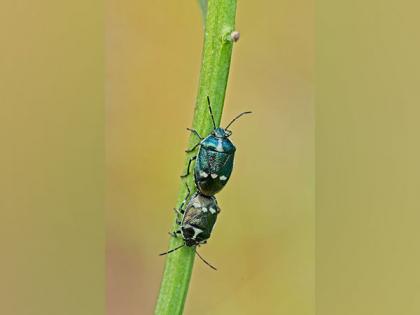Researchers find how ambrosia beetles identify their food fungi by their scents
By ANI | Published: April 17, 2023 02:18 PM2023-04-17T14:18:58+5:302023-04-17T14:20:10+5:30
Washington [US] April 17 : Active agriculture is practised by several species of ambrosia beetles. They cultivate and look ...

Researchers find how ambrosia beetles identify their food fungi by their scents
Washington [US] April 17 : Active agriculture is practised by several species of ambrosia beetles. They cultivate and look after food fungi in the wood of trees as social groups and control the growth of so-called weed fungi.
The findings of the study published in the journal Frontiers in Microbiology.
Researchers led by Prof. Dr. Peter Biedermann, professor of Forest Entomology and Forest Protection at the University of Freiburg, now demonstrate for the first time that ambrosia beetles can distinguish between different species of fungi by their scents. "The results can contribute to a better understanding of why beetles selectively colonise trees with conspecifics and how exactly their fungiculture works," said Biedermann. "In addition, the scents of the fungi could be used to develop attractants to control non-native ambrosia beetles."
For the first time, a research team led by Biedermann and the environmental scientist Dr. Antonio Gugliuzzo from the University of Cata/Italy was able to demonstrate that the black stem borer (Xylosandrus germanus) is capable of smelling the fungi that serve as its food source and that these scents serve as so-called aggregation pheromones. This indicates that the beetle searches for trees that have been colonised by conspecifics using the aroma of the feeding fungus. The invasive species of beetle, which is currently common in Germany, is primarily found in fruit trees.
"Until now, we could not explain how these beetles attack trees in groups," says Biedermann - because no corresponding scent of the insects' own had been found so far. The experiment now showed that the beetles react to the scents of the specific food fungi that their conspecifics have already cultivated in the branches of a tree. "This enables the beetles to colonise weakened trees in greater numbers and to overcome the tree's defences more easily, thus causing the tree to die," said Biedermann. Further chemical analyses can now be done to determine a component of the fungus scent, which could then be used as an attractant for traps in fruit growing.
Even larvae can distinguish fungi
In another study, environmental scientist Denicia Kassie and biologist Jna Diehl were able to experimentally demonstrate for the first time that another ambrosia beetle species, the fruit-tree pinhole borer (Xyleborinus saxesenii), can recognise and distinguish between its food fungi and so-called weed or harmful fungi based on their scents. Diehl is a doctoral student with Biedermann at the University of Freiburg. "Depending on the condition of the fungi, the beetles in the experiments either specifically sought out the fungal cultures or avoided them," says Diehl. The ability to recognise a potential threat to food fungi or their own health gives the beetles the opportunity to react - and either avoid or specifically combat the harmful fungi. The results of the study have been published in the journal Symbiosis.
The scientists were able to demonstrate the ability to distinguish between different food and harmful fungi in both larvae and adult individuals of the fruit-tree pinhole borer - which each take on their own tasks in the social network in the social maintenance of the food fungus cultures. "These findings are another building block to better understand how the control of fungal breeding by ambrosia beetles works functionally," said Biedermann. "This could also result in ideas for our agriculture to control harmful orgsms in a sustainable and environmentally friendly way."
Disclaimer: This post has been auto-published from an agency feed without any modifications to the text and has not been reviewed by an editor
Open in app